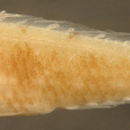Comprehensive Description
(
Inglês
)
fornecido por CoralReefFish
Description: This type shares the characteristic markings of larval and transitional Sparisoma. Recruits become distinct from S. viride early as melanophores extend onto the base of the central caudal fin rays and divide the light bar on the tail. The melanophores extending into the caudal bar extend further below the midline than above (vs. equal above and below in S. chrysopterum/rubripinne). Small juveniles tend to have dark patches along the lateral midline mostly below the level of the lateral line and do not develop an obvious white tail bar. Some individuals develop a marked bicolor pattern of light above the lateral line and dark below. Later juveniles are variably mottled with some light striping and spotting and are only identified by process of exclusion (or DNA sequence analysis). Individuals from Noronha in Brazil show a pattern of reduced body markings and intensified black markings on the fins.
- licença
- cc-by-3.0
- direitos autorais
- www.coralreeffish.com by Benjamin Victor
Diagnostic Description
(
Inglês
)
fornecido por CoralReefFish
Diagnosis: The larvae of all Sparisoma may well be identical, and DNA sequencing is required to identify species. Transitional recruits develop the basic markings probably shared by all members of the genus, but small juveniles of Sparisoma acquire distinct patterns that separate most, if not all, regional species. The DNA sequence of the juvenile specimen from Noronha in Brazil confirms that it is S. radians (Bernardi et al 2005), even though it displays a peculiar pattern of markings. S. atomarium may be indistinguishable from S. radians when juvenile specimens are found in the same habitat.
- licença
- cc-by-3.0
- direitos autorais
- www.coralreeffish.com by Benjamin Victor
Diagnostic Description
(
Inglês
)
fornecido por Fishbase
Front of upper jaw has horizontal canine-like tusks. 2 scales between bases of pelvic fins (Ref. 26938). Drab-phase fish are olivaceous to yellowish brow, finely speckled with pale dots, many are conjoined; base and axil of pectoral fins broadly blue-green. Terminal-phase males are greenish brown with faint pale dots, some scales with reddish edges; irregular orange-red markings on opercle; a blackish bar at pectoral base; a broad blackish border posteriorly on caudal fin (Ref. 13442).
- licença
- cc-by-nc
- direitos autorais
- FishBase
- Recorder
- Cristina V. Garilao
Morphology
(
Inglês
)
fornecido por Fishbase
Dorsal spines (total): 9; Dorsal soft rays (total): 10; Analspines: 3; Analsoft rays: 9
- licença
- cc-by-nc
- direitos autorais
- FishBase
- Recorder
- Cristina V. Garilao
Trophic Strategy
(
Inglês
)
fornecido por Fishbase
As an adult, it lives among seagrasses and feeds on them. When alarmed, S. radians follows an escape pattern of darting rapidly away and suddenly coming to rest motionless in the seagrass, where it assumes a mottled color pattern that makes it difficult to detect (Ref. 35209). Feeds primarily on epiphytes and seagrass blades, leaving crescent bite marks. Herbivore (Ref. 57616).
- licença
- cc-by-nc
- direitos autorais
- FishBase
Biology
(
Inglês
)
fornecido por Fishbase
Mostly found in seagrass beds in shallow, protected waters. Feeds primarily on epiphytes and seagrass blades, leaving crescent bite marks. Darts into seagrass when frightened (Ref. 9710).
- licença
- cc-by-nc
- direitos autorais
- FishBase
Importance
(
Inglês
)
fornecido por Fishbase
fisheries: of potential interest; aquarium: commercial
- licença
- cc-by-nc
- direitos autorais
- FishBase

